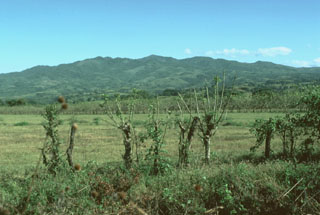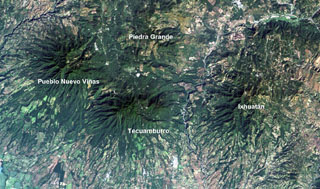

The Global Volcanism Program has no activity reports available for Ixhuatán.
The Global Volcanism Program has no Weekly Reports available for Ixhuatán.
The Global Volcanism Program has no Bulletin Reports available for Ixhuatán.
This compilation of synonyms and subsidiary features may not be comprehensive. Features are organized into four major categories: Cones, Craters, Domes, and Thermal Features. Synonyms of features appear indented below the primary name. In some cases additional feature type, elevation, or location details are provided.
Domes |
||||
| Feature Name | Feature Type | Elevation | Latitude | Longitude |
| Achiotes, Cerro los | Dome | 1460 m | 14° 10' 0" N | 90° 14' 0" W |
| Chino el Pital, Cerro | Dome | 1180 m | 14° 9' 0" N | 90° 14' 0" W |
| Tatascamital, Cerro | Dome | 1360 m | 14° 11' 0" N | 90° 13' 0" W |
|
|
||||||||||||||||||
The Global Volcanism Program is not aware of any Holocene eruptions from Ixhuatán. If this volcano has had large eruptions (VEI >= 4) prior to 12,000 years ago, information might be found on the Ixhuatán page in the LaMEVE (Large Magnitude Explosive Volcanic Eruptions) database, a part of the Volcano Global Risk Identification and Analysis Project (VOGRIPA).
There is no Deformation History data available for Ixhuatán.
There is no Emissions History data available for Ixhuatán.
 The western side of the low-angle, eroded Ixhuatán volcanic complex rises beyond the Río Los Esclavos as seen from the flank of Tecuamburro volcano. The 1718-m-high dominantly andesitic volcano is of Pliocene-Pleistocene age. The youngest center is a dacitic lava-dome complex at Cerro los Achiotes. The domes and associated ashfall and ashflow deposits partially fill and extend from a horseshoe-shaped caldera that is breached to the SE and may have formed as a result of slope failure.
The western side of the low-angle, eroded Ixhuatán volcanic complex rises beyond the Río Los Esclavos as seen from the flank of Tecuamburro volcano. The 1718-m-high dominantly andesitic volcano is of Pliocene-Pleistocene age. The youngest center is a dacitic lava-dome complex at Cerro los Achiotes. The domes and associated ashfall and ashflow deposits partially fill and extend from a horseshoe-shaped caldera that is breached to the SE and may have formed as a result of slope failure.  The eroded Plio-Pleistocene Ixhuatán volcano rises to the NE above the Pacific coastal plain of Guatemala. Ixhuatán has produced dominantly andesitic lava flows and volcaniclastic deposits. NE-SW-trending faults cut the volcanic complex. Pleistocene andesitic ignimbrite deposits from the neighboring Tecuamburro volcanic complex bank up onto the western flanks of Ixhuatán.
The eroded Plio-Pleistocene Ixhuatán volcano rises to the NE above the Pacific coastal plain of Guatemala. Ixhuatán has produced dominantly andesitic lava flows and volcaniclastic deposits. NE-SW-trending faults cut the volcanic complex. Pleistocene andesitic ignimbrite deposits from the neighboring Tecuamburro volcanic complex bank up onto the western flanks of Ixhuatán. Morning fog drapes the valley of the Río Margarita, with Ixhuatán volcano in the background. The broad summit of Tecuamburro volcano is visible to the west behind Ixhuatán on the horizon left of center. Los Ochiotes complex in the center of Ixhuatán volcano is the youngest part of the volcano and consists of a group of dacitic lava domes that fills a horseshoe-shaped depression open to the SE.
Morning fog drapes the valley of the Río Margarita, with Ixhuatán volcano in the background. The broad summit of Tecuamburro volcano is visible to the west behind Ixhuatán on the horizon left of center. Los Ochiotes complex in the center of Ixhuatán volcano is the youngest part of the volcano and consists of a group of dacitic lava domes that fills a horseshoe-shaped depression open to the SE.  Four large Pleistocene volcanic complexes are visible in this Landsat image of southern Guatemala, with the Pacific coastal plain at the bottom. Minor activity at Tecuamburro volcano continued into the Holocene at Laguna Ixpaco, the small circular white dot a little more than half-way between the Tecuamburro and Piedra Grande labels. The Río los Esclavos extends from the upper right, cutting between Tecuamburro and Ixhuatán volcanoes.
Four large Pleistocene volcanic complexes are visible in this Landsat image of southern Guatemala, with the Pacific coastal plain at the bottom. Minor activity at Tecuamburro volcano continued into the Holocene at Laguna Ixpaco, the small circular white dot a little more than half-way between the Tecuamburro and Piedra Grande labels. The Río los Esclavos extends from the upper right, cutting between Tecuamburro and Ixhuatán volcanoes.Maps are not currently available due to technical issues.
There are no samples for Ixhuatán in the Smithsonian's NMNH Department of Mineral Sciences Rock and Ore collection.
| Copernicus Browser | The Copernicus Browser replaced the Sentinel Hub Playground browser in 2023, to provide access to Earth observation archives from the Copernicus Data Space Ecosystem, the main distribution platform for data from the EU Copernicus missions. |
|
WOVOdat
Single Volcano View Temporal Evolution of Unrest Side by Side Volcanoes |
WOVOdat is a database of volcanic unrest; instrumentally and visually recorded changes in seismicity, ground deformation, gas emission, and other parameters from their normal baselines. It is sponsored by the World Organization of Volcano Observatories (WOVO) and presently hosted at the Earth Observatory of Singapore.
GVMID Data on Volcano Monitoring Infrastructure The Global Volcano Monitoring Infrastructure Database GVMID, is aimed at documenting and improving capabilities of volcano monitoring from the ground and space. GVMID should provide a snapshot and baseline view of the techniques and instrumentation that are in place at various volcanoes, which can be use by volcano observatories as reference to setup new monitoring system or improving networks at a specific volcano. These data will allow identification of what monitoring gaps exist, which can be then targeted by remote sensing infrastructure and future instrument deployments. |
| IRIS seismic stations/networks | Incorporated Research Institutions for Seismology (IRIS) Data Services map showing the location of seismic stations from all available networks (permanent or temporary) within a radius of 0.18° (about 20 km at mid-latitudes) from the given location of Ixhuatán. Users can customize a variety of filters and options in the left panel. Note that if there are no stations are known the map will default to show the entire world with a "No data matched request" error notice. |
| UNAVCO GPS/GNSS stations | Geodetic Data Services map from UNAVCO showing the location of GPS/GNSS stations from all available networks (permanent or temporary) within a radius of 20 km from the given location of Ixhuatán. Users can customize the data search based on station or network names, location, and time window. Requires Adobe Flash Player. |
| Large Eruptions of Ixhuatán | Information about large Quaternary eruptions (VEI >= 4) is cataloged in the Large Magnitude Explosive Volcanic Eruptions (LaMEVE) database of the Volcano Global Risk Identification and Analysis Project (VOGRIPA). |
| EarthChem | EarthChem develops and maintains databases, software, and services that support the preservation, discovery, access and analysis of geochemical data, and facilitate their integration with the broad array of other available earth science parameters. EarthChem is operated by a joint team of disciplinary scientists, data scientists, data managers and information technology developers who are part of the NSF-funded data facility Integrated Earth Data Applications (IEDA). IEDA is a collaborative effort of EarthChem and the Marine Geoscience Data System (MGDS). |